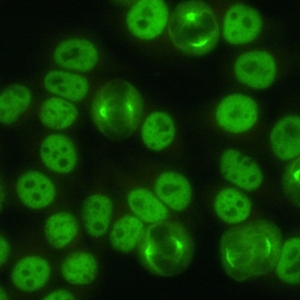 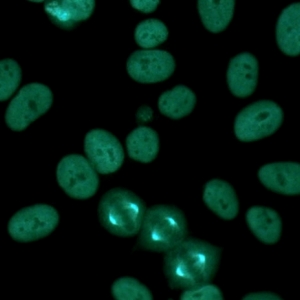 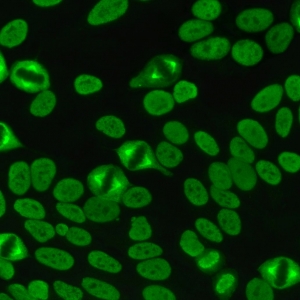 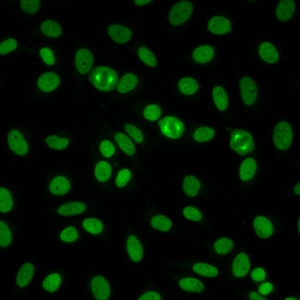 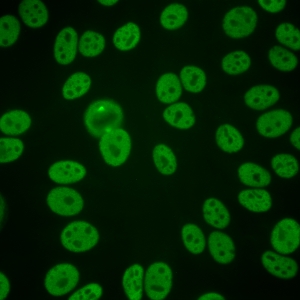 |
|
| Previous Nomenclature | MSA-1, centrophilin |
| Description | Nuclear speckled staining with spindle fibers. |
| Antigen Association | NuMA |
|
Clinical Relevance
First level information About Clinical Relevance & List of Abbreviations |
|
▶ Approximately one-half of the patients with the AC-26 pattern have clinical features of a SARD (SjS, SLE, UCTD, limited SSc, or RA); the AC-26 pattern is also observed in patients with organ-specific autoimmune diseases and less frequently in non-autoimmune conditions, especially when in low titer (109, 111–114) ▶ Found very infrequently in a routine serology diagnostic setting (109) ▶ Antigens recognized include NuMA, centrophilin, SP-H antigen and NMP-22; specific immunoassays for these autoantibodies are currently not commercially available (115) |
| First level information references |
|
109. Mozo L, Gutiérrez C, Gómez J, Gómez Jesús. Antibodies to mitotic spindle apparatus: clinical significance of NuMA and HsEg5 autoantibodies. J Clin Immunol 2008;28:285-90. 111. Szalat R, Ghillani-Dalbin P, Jallouli M, et al. Anti-NuMA1 and anti-NuMA2 (anti-HsEg5) antibodies: clinical and Immunological features: a propos of 40 new cases and review of the literature. Autoimmun Rev 2010;9:652-6. 112. Grypiotis P, Ruffatti A, Tonello M, et al. [Clinical significance of fluoroscopic patterns specific for the mitotic spindle in patients with rheumatic diseases]. Reumatismo 2002;54:232-7. 113. Price CM, McCarty GA, Pettijohn DE. NuMA protein is a human autoantigen. Arthritis Rheum 1984;27:774-9. 114. Bonaci-Nikolic B, Andrejevic S, Bukilica M, et al. Autoantibodies to mitotic apparatus: association with other autoantibodies and their clinical significance. J Clin Immunol 2006;26:438-46. 115. Compton DA, Szilak I, Cleveland DW. Primary structure of NuMA, an intranuclear protein that defines a novel pathway for segregation of proteins at mitosis. J Cell Biol 1992;116:1395-408. |
| Second level information |
|
None |
| Second level information references |
|
None
|
| FAQ |
|
How to deal with just a “nuclear speckled” IFA report? In my practice I have followed patients with ANA findings, with a nuclear speckled pattern (without specifying whether fine/dense/coarse), in patients with very heterogeneous phenotypes, some with a clinical picture that suggests further investigation of systemic autoimmune disease (one patient with proximal muscle weakness and skin thickening) and others who represent only non-specific findings. In such situations, as a precaution, I request more specific autoantibodies. However, this pattern (nuclear speckled pattern) is not described by the "ICAP" and I am in doubt about which antigenic association it represents, even to guide which autoantibody may be present and which ones to look after. How to interpret this pattern? Does the lab describe it when it is not possible to "refine" such a conclusion? Could this be associated with deficiency in the methodology, sample, interpretation? |